Artists in today’s digital age face unique challenges when marketing their work. With many platforms available, selecting the most effective methods can be daunting. One approach, however, stands out for its effectiveness and personal touch – email marketing.
Email marketing allows many artists to connect directly with their audience, bypassing the noise of social media and other crowded channels. It allows artists to showcase their work, share their inspiration and process, and build a loyal following. Reaching out regularly to your past customers and followers by email should be a key part of your Art Marketing Strategy.
In comparison to other marketing channels, email marketing offers several distinct advantages. It provides a direct line of communication to your audience, ensuring that your message reaches its intended recipient. It also allows for personalization and segmentation, enabling artists to tailor their messages to specific audience groups. Furthermore, it offers measurable results, with metrics such as open rate and click-through rate providing valuable insights into campaign performance.

For artists, the importance of email marketing cannot be overstated. It’s a powerful tool for building relationships, promoting work, and ultimately, driving sales.
Build Your Email List

Building an email list is the first step in the process of email marketing for artists. It’s not merely about accumulating a large number of email addresses; it’s about curating a list of individuals genuinely interested in your artwork, your creative process, and your journey as an artist. This engaged audience is more likely to become your loyal patrons, actively responding to your emails, attending your exhibitions, and purchasing your artwork.
There are several strategic ways to build your email:
Art Shows, Galleries, and Events
Physical venues where your art is displayed are prime locations for collecting email addresses. You can:
- Have a sign-up sheet at your booth: Make it visually appealing and inviting for visitors to leave their contact details.
- Offer a digital sign-up option: Use a tablet or smartphone, making it easy for the tech-savvy audience to subscribe.
- Host a mini-contest or raffle: This can encourage attendees to provide their email addresses for a chance to win a small piece of your artwork or a discount on their next purchase.
Lead Magnets and Freebies
These are incentives you offer to potential subscribers in exchange for their email addresses. For artists, effective lead magnets could include:
- A free digital print of your artwork: This can be an exclusive piece not available anywhere else.
- An exclusive behind-the-scenes video: Share your creative process, giving subscribers a glimpse into your art studio and the creation of a piece of art.
- Early access or discounts: Offer early access to your new collections or discounts on their first purchase.
Social Media
Your social media platforms can be powerful tools to drive email sign-ups. Here are some tips:
- Include a link to your email sign-up form in your bio: This is a common practice and followers often check the bio for more information.
- Promote your newsletter in your posts: Share snippets of your newsletter content on your social media to entice followers to subscribe.
- Use social media ads: Targeted ads can help reach a wider audience interested in your genre of art.
Remember, the goal is not just to build a large list, but to cultivate an engaged and interested audience. This approach will yield better results in your email marketing efforts.

Choosing an Email Marketing Platform
Choosing the right email marketing platform is a crucial step in your email marketing journey. The ideal platform should not only be user-friendly and feature-rich but also cost-effective, especially for artists who are just starting to build their email list.
| Key Considerations for Email Marketing Platforms |
|---|
| 1. Ease of Use: The platform should be user-friendly, with a clean and intuitive interface. Artists should be able to easily navigate the platform and understand its features without needing advanced technical skills. |
| 2. Automation Features: The platform should offer automation features, such as autoresponders and scheduling tools. These features can save time and effort by automating repetitive tasks. |
| 3. Segmentation Capabilities: The platform should allow artists to segment their email list based on various criteria, such as engagement level, purchase history, or interests. This enables artists to send personalized and relevant content to different groups of subscribers. |
| 4. Analytics and Reporting: The platform should provide detailed analytics and reporting tools to track the performance of email campaigns. This includes open rates, click-through rates, conversion rates, and other key metrics. |
| 5. Integration with Other Tools: The platform should integrate seamlessly with other tools that artists use, such as e-commerce platforms, CRM systems, and social media platforms. |
| 6. Pricing: The platform should offer flexible pricing options that fit the artist’s budget. Some platforms offer free plans for small email lists, while others charge based on the number of subscribers or emails sent. |
| 7. Customer Support: The platform should provide reliable customer support to help artists resolve any issues they may encounter. |
| 8. Email Templates: The platform should offer a variety of customizable email templates. This allows artists to create visually appealing emails that reflect their unique style and brand. |
Here are some email marketing platforms that offer free or low-cost plans, making them ideal for artists with a smaller list:
Mailchimp
Mailchimp’s free tier allows you to send up to 10,000 emails per month to a list of up to 2,000 subscribers. It’s a great option for artists just starting out with email marketing. The platform offers a user-friendly interface and a range of customizable templates. However, the free tier lacks advanced segmentation and automation features, which are available in the paid plans.
MailerLite
With MailerLite, you can send up to 12,000 emails per month to 1,000 subscribers for free. It provides a user-friendly drag-and-drop editor for designing appealing emails. The plan includes basic features such as segmentation and automation, along with the ability to create landing pages and promotional pop-ups. However, if you require advanced features like auto-resend, delivery by timezone, and click maps, you will need to upgrade to a paid plan.
Brevo (formerly known as Sendinblue)
Brevo’s free plan allows you to send up to 300 emails per day. It’s a good option if you have a smaller list but want to send emails more frequently. The platform also offers SMS marketing and chat features. However, the free plan only includes basic email templates, and for more customization options, you’ll need to upgrade.
Mailjet
Mailjet’s free tier allows you to send up to 6,000 emails per month (300 emails per day). It’s a solid choice for artists with a moderate-sized email list. The platform offers a user-friendly interface and a range of customizable templates. However, the free tier lacks advanced segmentation and automation features, which are available in the paid plans.
The best email marketing service for you will depend on your specific needs and budget. All of these email programs offer free tiers that can help you get started with email marketing, and they all offer paid plans that provide additional features and capabilities. As an artist, email marketing can help you connect with your audience, promote your work, and grow your business.

Creating Engaging Content for Your Email List
The art of email marketing lies in creating engaging content. As an artist, your emails are an extension of your creativity, serving as a canvas to paint your story and showcase your work. Let’s delve deeper into the types of content you can include in your artist newsletters:
Behind-the-scenes Stories and Insights
This is your chance to pull back the curtain and reveal the artist behind the art. You can:
- Share early sketches and drafts of your work, providing a visual journey of your creative process.
- Give subscribers a virtual tour of your workspace or art studio, showing where the magic happens.
- Discuss challenges you faced while creating a piece and how you overcame them, adding a human touch to your art.
- Show a time-lapse video of you creating a piece, offering a dynamic glimpse into your art production.
Showcasing New Artwork and Collections
Your email newsletter is an ideal platform to debut new artwork and collections. Make sure to:
- Include high-quality images of your new artwork, allowing your subscribers to see the fine details.
- Write a brief story for each piece, sharing the inspiration behind it.
- For collections, explain the theme that unites the pieces, giving subscribers a deeper understanding of your work.
- Include a ‘buy now’ button or link for each piece, making it easy for interested subscribers to make a purchase.
Sharing Artist’s Inspiration and Creative Process
Sharing what inspires you can make your art more relatable and engaging. Consider:
- Discuss your sources of inspiration, whether it’s nature, literature, culture, or personal experiences.
- Explaining how these inspirations manifest in your artwork, helping subscribers see your work in a new light.
- Sharing photos or anecdotes of your inspiration sources adds a personal touch to your newsletter.
Promoting Events and Exhibitions
If you’re participating in art shows or exhibitions, your newsletter is a great way to invite your subscribers. Be sure to:
- Provide the date, time, and location of the event.
- Explain what visitors can expect, such as the number and type of pieces on display.
- Highlight any special activities or features of the event, like live demonstrations or meet-and-greets.
- If tickets are required, include information on how to purchase them.
Your email newsletter is an essential marketing tool to build your art business. By sharing engaging content, you can grow your email list, nurture relationships with your subscribers, and ultimately, sell more art.
| Tips for Writing a Successful Marketing Email |
|---|
| Craft a compelling subject line: Your subject line is the first thing your subscribers see, so make it count. It should be short, intriguing, and provide a clear idea of what the email is about. For example, “Unveiling My Latest Art Piece!” or “Exclusive Invitation to My Art Show.” |
| Personalize your emails: Personalization goes beyond just addressing your subscribers by their names. Try to tailor the content of your emails to fit the interests of your subscribers. For example, if you know a group of your subscribers are interested in a specific art style you practice, send them emails featuring your work in that style. |
| Provide value: Always aim to provide value in your emails. This could be through sharing insights about your creative process, offering exclusive deals or early access to your new work, or providing useful tips and resources related to art. |
| Use clear and concise language: Keep your emails short and to the point. Break up text into smaller paragraphs or bullet points to make it easier to read. Also, ensure your message is written in a clear and concise manner that is easy to understand. |
| Include a clear call-to-action (CTA): Every email should have a purpose, whether it’s to direct subscribers to your latest blog post, invite them to an upcoming event, or encourage them to purchase a piece of art. Make sure your CTA is clear, concise, and easy to find. |
Creating engaging email content may require time and effort, but it’s an investment that can significantly enhance your connection with your audience and boost your art sales.
Email Campaign Frequency and Timing

The frequency and timing of your emails can significantly impact the success of your email marketing strategy. Striking the right balance can keep your email subscribers engaged and eager for your next update. Here’s how you can determine the optimal frequency and timing for your emails:
Determining the Optimal Frequency
The ideal frequency for sending emails depends on your content and your audience’s preferences. Here’s how you can figure it out:
- Start with a bi-weekly or monthly schedule: This frequency gives you enough time to create quality content for your email campaigns without overwhelming your subscribers.
- Listen to your audience: If your subscribers frequently mention they enjoy your regular emails and want more, it might be a sign to increase your frequency.
- Monitor your unsubscribe rates: If you notice an increase in people opting out of your email list after increasing your frequency, it might be time to scale back.
Testing Different Schedules
Experimenting with different schedules can help you understand what works best for your audience. Consider the following:
- Try sending emails on different days of the week: Some email marketing guides suggest that emails sent on Tuesday and Thursday have higher open rates.
- Experiment with different times: Depending on your audience, you might find that emails sent in the morning have higher open rates than those sent in the afternoon or evening.
- Test different frequencies: Adjust your frequency (weekly, bi-weekly, monthly) and monitor how it impacts your engagement rates.
Considerations for Timing Emails
When scheduling your emails, consider your audience’s habits and preferences. For instance:
- If your audience is made up of working professionals, sending emails during the workweek might yield better open rates.
- If you have international subscribers, consider their time zones when scheduling your emails.
Remember, there’s no one-size-fits-all strategy when it comes to email frequency and timing. It’s about understanding your audience, testing different schedules, and refining your process based on your results. By doing so, you can ensure your emails are a welcome sight in your subscribers’ inboxes, helping you build stronger relationships and sell more art online.
What are the legal considerations I should be aware of in email marketing?
Adhering to these laws will help protect your art business and maintain trust with your subscribers. Here are some key legal considerations:
Email marketing is a powerful tool for artists, but it’s important to use it responsibly. By understanding and adhering to these legal considerations, you can use email marketing to build strong relationships with your audience, grow your list, and sell more art online, all while staying on the right side of the law.
Tracking and Analyzing Email Performance
Tracking and analyzing your email performance is crucial to improving your email marketing strategy. By monitoring key metrics, you can gain insights into your subscribers’ behaviors and preferences, allowing you to make data-driven decisions to optimize your emails. Here are some key metrics to monitor:
| Open Rates | This metric tells you how many people opened your email. A low open rate could indicate that your subject line isn’t compelling enough or that your emails are landing in the spam folder. |
| Click-Through Rates (CTR) | This measures how many people clicked on a link in your email. It can help you understand how engaging your content is and whether your calls-to-action are effective. |
| Bounce Rates | This shows the percentage of emails that weren’t successfully delivered to the recipient’s inbox. A high bounce rate could indicate that many email addresses on your list are invalid. |
| Unsubscribe Rates | This is the rate at which people are unsubscribing from your list. A high unsubscribe rate could indicate that your content isn’t meeting your subscribers’ expectations. |
| Conversion Rates | This measures how many subscribers completed a desired action, such as making a purchase or signing up for an event. This is one of the best ways to measure the success of your email marketing. |
Apart from these metrics, you should also pay attention to the feedback and responses you receive from your subscribers. This can provide valuable insights into what your audience enjoys and what they’d like to see more of.
Converting Subscribers into Art Buyers

While building a large email list is a great accomplishment, the ultimate goal of email marketing is to convert those subscribers into buyers. Here are some strategies to help you drive sales through email marketing:
1. Creating Compelling Calls-to-Action (CTAs): Your emails should always include a clear and compelling CTA that directs subscribers to take a specific action. Whether you want them to view a new collection, purchase a piece of art, or register for an event, your CTA should be straightforward and enticing.
2. Offering Exclusive Deals or Discounts: Everyone loves a good deal. Offering exclusive discounts or special promotions to your email subscribers can incentivize them to make a purchase. Just be sure not to overdo it, as this can devalue your art over time.
3. Building Trust and Relationships: People are more likely to buy from artists they know and trust. Use your emails to build a relationship with your subscribers. Share stories about your art, your inspiration, and your creative process. Show them that there’s a real person behind the art they love.
4. Showcasing Customer Testimonials: If you have positive reviews or testimonials from past buyers, share them in your emails. This social proof can help reassure potential buyers that they’re making a good decision.
5. Providing a Seamless Buying Experience: Make it as easy as possible for your subscribers to make a purchase. This means having a user-friendly website, a simple checkout process, and clear information about shipping and returns.
By implementing these strategies, you can turn your email subscribers into loyal customers. Remember, it’s not just about making a single sale. It’s about building long-term relationships that lead to repeat sales and referrals.
Best Practices for Maintaining Email List Health
Email List management is an essential aspect of successful email marketing. As an artist, you want to ensure that your emails reach the inboxes of your subscribers, and that your list is full of engaged and interested followers. Here’s how you can maintain your email list health:
Maintaining your email list health is a continuous task, but it’s essential for successful email marketing. By keeping your list clean and engaged, you can ensure your emails reach the inboxes of your subscribers and achieve better results with your email marketing efforts.
Winning at Email Marketing for Artists

Email marketing is a powerful tool artists can use to build meaningful relationships with their audience and sell art online. By diligently building your email list and crafting engaging content, you can showcase your unique artistry, share your creative journey, and connect with your audience on a deeper level.
The content of your emails should be more than just promotional. It should provide value to your subscribers. Consider sharing behind-the-scenes stories, insights into your creative process, and the inspiration behind your art. This type of content marketing allows your audience to connect with you as an artist and appreciate your art on a deeper level.
As you continue to grow your email list and refine your email marketing strategies, you’ll find that you’re not just increasing your number of subscribers, but also converting more of them into buyers. This can significantly help artists in growing their art business.
The key to successful email marketing is to track and analyze your email performance. By monitoring key metrics like open rates, click-through rates, and conversion rates, you can gain actionable insights and make data-driven decisions to improve your emails.
Email marketing offers tremendous benefits for artists. It’s a journey that requires time and effort, but the rewards in terms of audience engagement and art sales can be substantial. So, start building your email list, create an email that reflects your unique artistry, and embark on this rewarding journey of connecting with your audience and growing your art business. You’ve got this!
